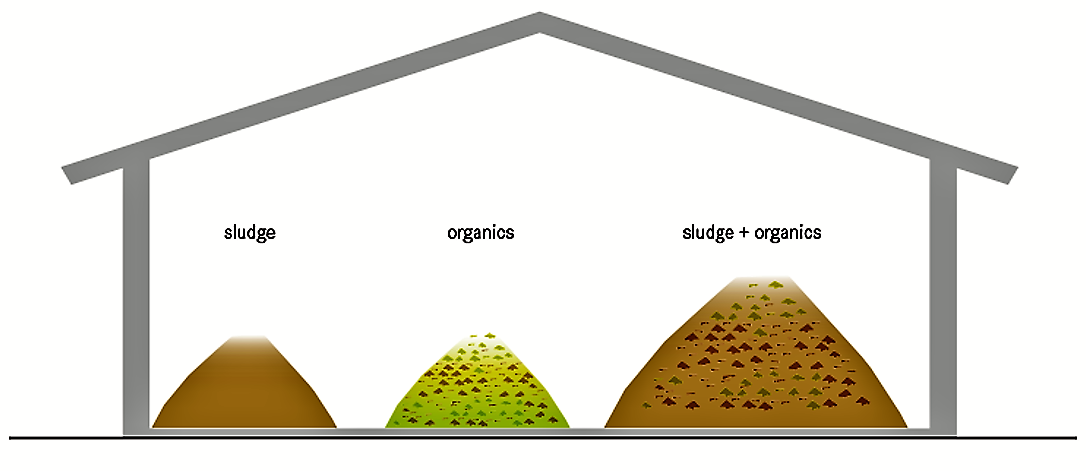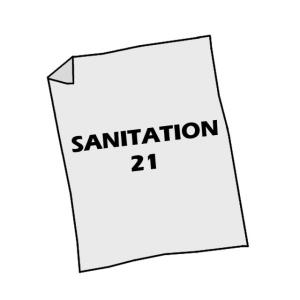Co-composting is the controlled aerobic degradation of organics, using more than one feedstock (faecal sludge and organic solid waste). Faecal sludge has a high moisture and nitrogen content, while biodegradable solid waste is high in organic carbon and has good bulking properties (i.e., it allows air to flow and circulate). By combining the two, the benefits of each can be used to optimize the process and the product.
| In | Out |
|---|---|
Compost/Biosolids |
There are two types of co-composting designs: open and in-vessel. In open composting, the mixed material (sludge and solid waste) is piled into long heaps called windrows and left to decompose. Windrow piles are periodically turned to provide oxygen and ensure that all parts of the pile are subjected to the same heat treatment. In-vessel composting requires controlled moisture and air supply, as well as mechanical mixing. Therefore, it is not generally appropriate for decentralised facilities.
Although the composting process seems like a simple, passive technology, a well-working facility requires careful planning and design to avoid failure.

The facility should be located close to the sources of organic waste and faecal sludge to minimize transport costs, but still at a distance away from homes and businesses to minimize nuisances. Depending on the climate and available space, the facility may be covered to prevent excess evaporation and/or provide protection from rain and wind. For dewatered sludge, a ratio of 1:2 to 1:3 of sludge to solid waste should be used. Liquid sludge should be used at a ratio of 1:5 to 1:10 of sludge to solid waste
Windrow piles should be at least 1 m high and insulated with compost or soil to promote an even distribution of heat inside the pile.
Maintaining the temperature in the pile between 55 and 60°C can reduce the pathogen load in sludge to a level safe to touch and work with. Although the finished compost can be safely handled, care should be taken when dealing with the sludge, regardless of the previous treatment. If the material is found to be dusty, workers should wear protective clothing and use appropriate respiratory equipment. Proper ventilation and dust control are important.
The mixture must be carefully designed so that it has the proper C:N ratio, moisture and oxygen content. If facilities exist, it would be useful to monitor helminth egg inactivation as a proxy measure of sterilization.
A well-trained staff is necessary for the operation and maintenance of the facility. Maintenance staff must carefully monitor the quality of the input material, and keep track of the inflows, outflows, turning schedules, and maturing times to ensure a high quality product. Forced aeration systems must be carefully controlled and monitored.
Turning must be periodically done with either a front-end loader or by hand. Robust grinders for shredding large pieces of solid waste (i.e., small branches and coconut shells) and pile turners help to optimize the process, reduce manual labour, and ensure a more homogenous end product.
A co-composting facility is only appropriate when there is an available source of well-sorted biodegradable solid waste. Solid waste containing plastics and garbage must first be sorted. When carefully done, co-composting can produce a clean, pleasant, beneficial soil conditioner.
Since moisture plays an important role in the composting process, covered facilities are especially recommended where there is heavy rainfall.
Apart from technical considerations, composting only makes sense if there is a demand for the product (from paying customers). In order to find buyers, a consistent and good quality compost has to be produced; this depends on good initial sorting and a well-controlled thermophilic process.
Composting and Its Applicability in Developing Countries
This informal paper argues that composting should be a more widespread practice, especially in developing countries. It reviews past composting experiences and provides an outline for municipal managers to use when evaluating composting programs within an integrated municipal waste management system.
HOORNWEG, D. THOMAS, L. OTTEN, L. (2000): Composting and Its Applicability in Developing Countries. (= Urban Waste Management Working Paper Series , 8 ). Washington, D.C.: The World Bank URL [Accessed: 05.06.2019]Helminth Eggs Inactivation Efficiency by Faecal Sludge Dewatering and Co-Composting in Tropical Climates
This study investigates helminth eggs removal and inactivation efficiency in a treatment process combining faecal sludge (FS) dewatering and subsequent co-composting with organic solid waste as a function of windrow turning frequency.
KONE, D. ; COFIE, O. ; ZURBRUEGG, C. ; GALLIZZI, K. ; MOSER, D. ; DRESCHER, S. ; STRAUSS, M. (2007): Helminth Eggs Inactivation Efficiency by Faecal Sludge Dewatering and Co-Composting in Tropical Climates. In: Water Research: Volume 41 , 4397-4402.Integrated Resource Recovery. The Co-Composting of Domestic Solid and Human Wastes
This report a valuable reference for decision makers and planners on co-composting when addressing waste management and resource recovery issues in the developing countries.
OBENG, L. A. WRIGHT, F. W. (1987): Integrated Resource Recovery. The Co-Composting of Domestic Solid and Human Wastes. Washington, D.C.: The World Bank and UNDP URL [Accessed: 21.07.2014]Marketing Compost. A Guide for Compost Producers in Low and Middle-Income Countries
This guide describes a marketing approach to composting, and is intended to help compost producers run more viable initiatives by unlocking the value of their product. The handbook does not cover everything there is to know about marketing, but starts with the basics and introduces the key principles and techniques. These include understanding the ‘marketing environment’, identifying appropriate target customer groups, and developing and promoting products to suit the market.
ROUSE ROTHENBERGER, S. ZURBRUEGG, C. (2008): Marketing Compost. A Guide for Compost Producers in Low and Middle-Income Countries. Duebendorf: Water and Sanitation in Developing Countries (SANDEC), Swiss Federal Institute for Environmental Science (EAWAG) URL [Accessed: 27.05.2019]Faecal Sludge Management
This is the first book to compile the current state of knowledge on faecal sludge management. It addresses the organization of the entire faecal sludge management service chain, from the collection and transport of sludge, to the current state of knowledge of treatment options, and the final end use or disposal of treated sludge. It presents an integrated approach that brings together technology, management, and planning, based on Sandec’s 20 years of experience in the field. It also discusses important factors to consider when evaluating and upscaling new treatment technology options. The book is designed for undergraduate and graduate students, engineers, and practitioners in the field who have some basic knowledge of environmental and/or wastewater engineering.
STRANDE, L. ; RONTELTAP, M. ; BRDJANOVIC, D. (2014): Faecal Sludge Management. Systems Approach for Implementation and Operation. London: IWA Publishing URL [Accessed: 16.07.2014]Co-composting of Faecal Sludge and Municipal Organic Waste
The document gives an overview on the combined composting of (faecal) sludges and organic solid waste based on a pilot project in Kumasi, Ghana. Results of the investigation should help the city’s waste management department to develop its biosolids management strategy and enable the project team to develop guidelines for planners and engineers on the option of co-composting.
STRAUSS, M. DRESCHER, S. ZURBRUEGG, C. MONTANGERO, A. OLUFUNKE, C. DRECHSEL, P. (2003): Co-composting of Faecal Sludge and Municipal Organic Waste. Swiss Federal Institute of Aquatic Science (EAWAG), Department of Water and Sanitation in Developing Countries (SANDEC) and International Water Management Institute (IWMI) URL [Accessed: 05.06.2019]











